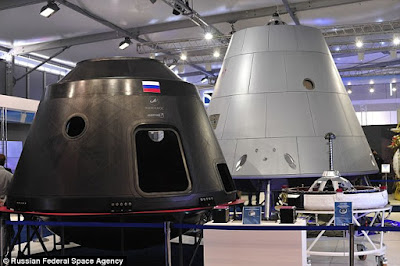Russian next generation Soyuz
Russia has been working on a new spacecraft to get cosmonauts to the moon and Mars.
Now, the Russian Space Agency revealed
images of the new, unnamed spacecraft, which has been under development
for around a decade.
It looks remarkably similar to Orion – Nasa's new spaceship designed to carry humans to an asteroid, and eventually to Mars.
It is designed to replace Soyuz-TMA that carries astronauts and cosmonauts to the International Space Station.
RSC Energia says it will test it over the
next few months, which the first unmanned orbital test flight of the new
spacecraft scheduled in 2021.
Earlier this year, Russia announced plans
to send manned flights to the moon by 2030 after reviving its lunar
programme with unmanned spacecraft.
It was the first time Moscow had set a
deadline for the space plans, hoping to recapture the early glory of the
first space race, when they beat the U.S. at getting a man to orbit the
earth.
Barack Obama previously wanted to get Americans onto Mars by 2030.
A Roscosmos spokesman said at the time: 'Close to 2030, the plan is to move over to manned flights to the Moon.'
The agency also announced that it would
continue to work with Nasa on the ISS until 2024, when it hopes to build
its own orbital station.
It says the station would aim to provide Russia 'with guaranteed access to the cosmos'.
Russian government officials had indicated
last year that they may end funding of the ISS in 2020, amid strained
relations between the the U.S and Russia over the Ukraine sanctions
row.
Extensive cooperation in space between
Washington and Moscow came under renewed pressure after the U.S banned
high-tech exports to Russia.
But that proposal appears to have been rejected in favour of keeping it going for another four years, as Nasa had suggested.
The space industry has been the root of fierce competition between Russia and the U.S dating back to the Cold War.
The U.S and the Soviet Union were locked in the so-called 'space race' for decades.
Russia's Yuri Gagarin was the first man in
space in 1961 and Neil Armstrong of the United States was the first man
on the Moon in 1969.
But with the Cold War over, competition gave way to cooperation.
Russia's subsequently deorbited its own Mir space station in 2001 as Moscow sought to concentrate its resources on the ISS.



